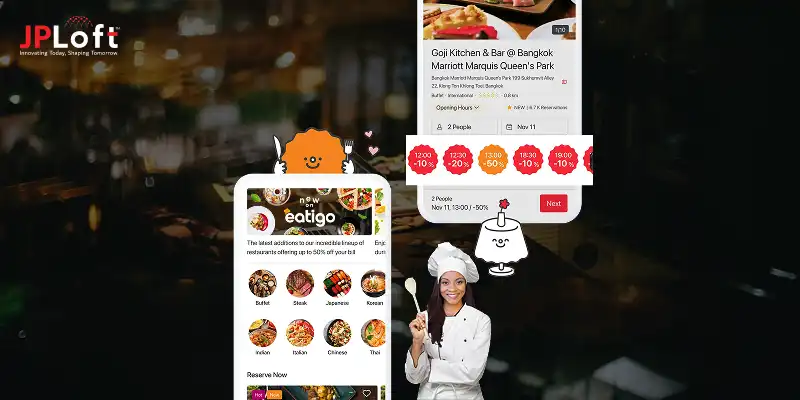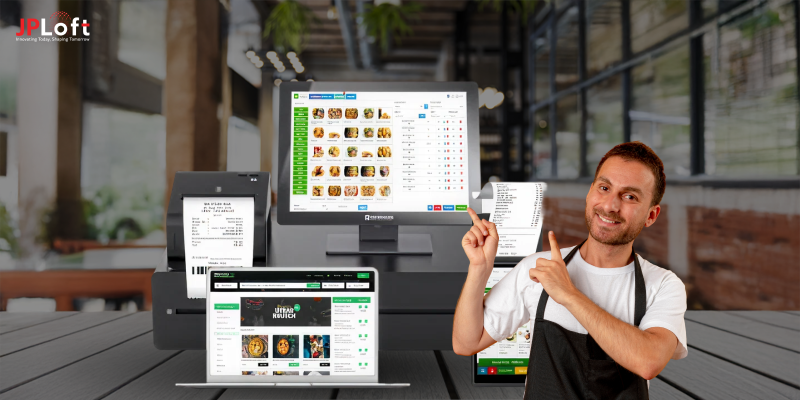Launching your restaurant app on the Apple App Store is a major milestone that brings your brand closer to millions of iPhone users. But the process can be tricky if you’re not familiar with Apple’s strict submission and review guidelines.
This guide covers everything from meeting Apple’s technical requirements to ensuring faster approval and optimizing your app for post-launch growth.
Whether you’re a first-time founder or an experienced entrepreneur, it provides a clear roadmap to confidently launch a restaurant app on the App Store and make it stand out in a competitive marketplace.
Things to Consider Before Launching a Restaurant App on the iOS Store
Before you start the submission process, it’s crucial to prepare your app to meet Apple’s quality, design, and performance standards. Apple prioritizes apps that offer a seamless user experience and follow their Human Interface Guidelines.
1. Understand Apple’s App Review Guidelines
Review Apple’s App Store Review Guidelines carefully. Ensure your app aligns with their rules for functionality, design, and user data protection. Even small non-compliance issues can delay approval.
2. Plan Features and User Flow
List your core features: table reservations, menu viewing, delivery tracking, or AI-based recommendations and refine the user journey for simplicity. It’s best to reference how to develop a restaurant app to understand the right development structure and flow that Apple expects.
3. Focus on UI/UX and Branding
The App Store emphasizes polished design and accessibility. Your icons, color schemes, and layout should feel native to iOS. Test your designs on multiple Apple devices to ensure consistency.
4. Budgeting and Pre-Launch Preparation
Account for expenses related to design, testing, developer licenses, and post-launch updates. Having clarity on the cost to develop a restaurant app helps you plan resources efficiently and avoid last-minute bottlenecks.
5. Test Before Submission
Conduct internal testing using TestFlight or Xcode simulators to identify bugs or performance issues before Apple’s review team does. A stable and bug-free app increases your approval chances significantly.
Technical Requirements for Restaurant App Submission on iOS Store
Before understanding the process to launch a restaurant app on the iOS Store, you need to ensure it meets Apple’s technical and compliance standards. Apple’s ecosystem is built on precision, performance, and security, so every app must align with these principles before submission.
1] Apple Developer Account and Certificates
To publish a restaurant app on the App Store, you’ll need an Apple Developer account. It allows you to access development tools, upload builds, and manage releases through App Store Connect.
2] App Store Connect Configuration
App Store Connect acts as the central hub for your app’s metadata, pricing, and submission details. Make sure all fields, app name, category, keywords, and privacy URLs are correctly filled out. Incomplete or misleading information is a common cause of delays.
3] App Build & Testing Compliance
Use Xcode or Transporter to upload your final build. Before that, run extensive testing to identify performance bottlenecks or design inconsistencies. Many developers rely on insights from the restaurant app development challenges to overcome common technical obstacles like integration errors or crashes during review.
4] Privacy Policies & Permissions
Apple enforces strict privacy policies. Apps that access user location, payment data, or photos must explicitly justify their use. Apps that implement AI-driven recommendations, an emerging restaurant app development trend, should clearly mention how user data is utilized to personalize experiences.
5] UI/UX Compliance and Design Consistency
Every visual element, from icons to navigation, should align with Apple’s Human Interface Guidelines. If you’re designing for multiple devices, maintain a consistent and cohesive design language to deliver a visually seamless user experience.
6] Choosing the Right Tech Stack
Selecting the right backend and frontend technologies determines performance and scalability. Referencing the restaurant app tech stack ensures your app runs smoothly across devices and stays future-ready.
7] Feature Optimization
Keep your app lightweight yet functional. Integrate must-have elements like push notifications, analytics, and payment gateways. You can study top restaurant app features.
to identify what users expect in a successful iOS dining app.
With learning these technical requirements, let’s get ahead with the key steps to submit your restaurant app on iOS Store in the following section.
Steps to Submit Your Restaurant App on iOS Store
If you’re wondering how to launch a restaurant app on the iOS Store?, the process may seem complex at first, but following a systematic approach can make it smooth and hassle-free.
Let’s explore the essential steps to successfully launch a restaurant app on the App Store.
Step 1: Prepare Your App Build and Assets
Before submission, ensure your app build is finalized and error-free. Use Xcode to archive your app and validate it through Apple’s tools.
Collect all assets screenshots, icons, and app previews formatted according to Apple’s specifications.
If you’re unsure about functionality standards, check examples like how to build an app like The Fork to understand how leading restaurant apps maintain performance and user experience consistency.
Step 2: Upload Your App Using Xcode or Transporter
Once the build is ready, upload it via Xcode or Apple Transporter. Make sure the version and build numbers are unique. The upload process also includes signing your app with valid certificates for verification.
If you’re working with reservation-focused functionality, comparing the cost to build a restaurant reservation app like OpenTable can help you align performance expectations and technical scalability.
Step 3: Configure App Information in App Store Connect
After uploading, head to App Store Connect to enter your app's details, title, category, description, keywords, and privacy information.
Accuracy here is key since Apple reviewers use this data to evaluate your app’s purpose.
Include clear descriptions of unique features, especially if AI-driven.
Before submission, run thorough restaurant app testing to identify bugs, optimize performance, and ensure full compliance with Apple’s review standards.
Step 4: Submit Your App for Review
When ready, select “Submit for Review.” Apple’s review process may take anywhere between 1 to 3 business days.
During this stage, ensure your app doesn’t violate any guidelines and that in-app purchases, permissions, and links work flawlessly.
Successful submission requires patience and precision, — critical for anyone looking to launch a restaurant app on the iOS Store successfully.
Step 5: Release and Monitor Performance
Once Apple approves your app, set the release type to manual or automatic and launch it for users. Keep track of analytics to monitor downloads, crashes, and user behavior.
Regular updates and quick fixes help improve app ranking and visibility. As you scale, you can explore how to create a mobile app ecosystem that integrates new features like loyalty programs, table booking, or AI-based recommendations.
Step 6: Optimize App Store Listing (ASO)
Your work doesn’t end after submission; visibility matters. Optimize your app store listing with relevant keywords, high-quality screenshots, and a compelling description.
App Store Optimization (ASO) helps your restaurant app stand out, attract organic traffic, and improve conversion rates. A great icon and video preview can make all the difference in catching a user’s attention.
Step 7: Manage App Reviews and Feedback
Once users start downloading your app, actively monitor and respond to reviews. Addressing user feedback shows credibility and commitment.
Positive reviews boost your app’s visibility, while constructive feedback provides valuable insights into potential improvements. Consider implementing in-app prompts encouraging satisfied users to rate your app.
Step 8: Regular Maintenance and Updates
Even after launch, your app’s journey continues. Regular restaurant app maintenance ensures smooth performance, compatibility with new iOS versions, and timely feature updates.
Fix bugs quickly, introduce new features, and refine existing ones based on analytics and user behavior. Apple values actively maintained apps; it’s key to retaining visibility and ensuring long-term success on the App Store.
Now that you know how to submit your restaurant app to the iOS Store, it’s equally important to understand what might stop it from getting approved. Let’s uncover the common reasons why restaurant apps face rejection and how you can avoid them.
Common Reasons Why Restaurant Apps Get Rejected on the iOS Store
Many developers struggle with the restaurant app approval on the Apple App Store due to avoidable mistakes. Understanding these issues beforehand can save valuable time during the submission phase.
Below are the top reasons why a restaurant app gets rejected on the iOS Store and how you can avoid them.
► UI/UX or Performance Issues
Apple prioritizes seamless performance and intuitive interfaces. Apps with broken navigation, slow loading times, or crashes are instantly flagged.
Reviewing best practices in restaurant app design can help you spot and fix common UX pitfalls that often lead to App Store rejections.
► Incomplete or Misleading App Information
If your app description, screenshots, or metadata don’t align with its actual functionality, Apple may reject it. Ensure every detail, privacy URLs, app icons, and feature lists are accurate and transparent.
► Policy or Privacy Violations
Apple has strict privacy and data-sharing rules. Apps collecting user data without consent or unclear policy explanations are denied access.
Modern tools like AI in restaurant apps can help automate compliance tracking and flag potential violations early.
► Low-Quality or Redundant Content
Apple discourages apps that duplicate existing products or offer little value to users. If your app feels too generic, explore creative restaurant app ideas to uncover unique features and experiences that can set your product apart from the competition.
► Lack of Functionality or Testing
Unfinished or buggy builds are common rejection triggers. Before submission, run end-to-end testing across iOS devices.
Using insights from how to start an online restaurant business can help structure your app for market viability and long-term sustainability.
► AI or Automation Misuse
If your app integrates AI features, ensure they enhance rather than replace the user experience. Apple rejects apps that misuse automation or generate low-quality recommendations. To ensure balance, study real-world cases to build an AI app
to understand compliance in AI-based restaurant platforms.
Even with careful planning, rejections can happen, but understanding these reasons helps you prepare better and launch a restaurant app on the iOS Store successfully.
What to Do if Your Restaurant App Gets Rejected?
Receiving a rejection from Apple can feel discouraging, but it’s a common part of the restaurant app approval process on the Apple App Store.
Knowing the right steps can help you launch a restaurant app on the App Store quickly and effectively.
1. Understand the Rejection Reason
Apple always provides a detailed explanation of why your app was rejected. Review it carefully to pinpoint issues, whether they are UI/UX flaws, privacy violations, or incomplete metadata. Understanding these areas reduces repeated rejection cycles.
2. Fix Technical or Functional Issues
Address the issues highlighted by Apple. Many developers rely on restaurant app maintenance practices to update code, fix crashes, and enhance overall stability before resubmission.
3. Improve Your Monetization Strategy
If your app involves in-app purchases, subscriptions, or reservation fees, ensure your payment flows are fully compliant.
Learning how restaurant apps make money can help optimize revenue models and meet Apple’s requirements.
4. Leverage AI for Compliance and Enhancement
If your app integrates AI, use it to improve user experience, automate table reservations, or provide intelligent suggestions.
Understanding the role of AI agents in restaurant apps ensures your app offers value without violating App Store policies.
5. Partner With Expert Developers if Needed
Sometimes rejections are due to deeper technical or architectural issues. Collaborating with an AI app development company can help redesign problematic areas, implement robust solutions, and expedite approval.
By following these steps, you increase your chances launch a restaurant app on the iOS Store successfully, turning rejection into an opportunity to refine your app and enhance user satisfaction.
Best Practices to Get Faster Approval for Your Restaurant App
Getting Apple’s green light isn’t just about submitting a functional app; it’s about following the best practices to consider for launching your restaurant app on the iOS Store that align with Apple’s design, security, and performance standards.
► Adhere Strictly to Apple’s Guidelines
Before submission, ensure your app complies with the App Store Review Guidelines.
Apps that mimic others, include incomplete metadata, or collect user data without permission often face rejection.
Understanding the process to launch a restaurant app on the App Store thoroughly helps you stay ahead of these pitfalls.
► Optimize Performance and Loading Speed
Your restaurant app should load smoothly and respond quickly. Apps that lag or crash during navigation can easily get flagged.
During testing, you can reference insights from how to build a restaurant booking app to understand performance expectations in reservation workflows.
► Ensure Accurate Functionality and UX Consistency
Check every button, menu, and reservation flow carefully, as Apple places high importance on precise UX design. Developers often emphasize maintaining a clean layout and error-free location tracking, both of which are critical for smooth functionality and App Store approval.
► Integrate AI Responsibly and Intelligently
AI can dramatically improve personalization from predictive ordering to table allocation.
When designing AI-powered features, review resources like how to build an AI table reservation app to ensure ethical AI use and compliance with Apple’s data-handling standards.
► Collaborate With Experienced Developers
Working with an on-demand app development company can speed up development and testing cycles.
These professionals understand Apple’s evolving requirements and can fine-tune your submission to ensure success.
Following these strategies answers the common query of how to launch a restaurant app on the iOS Store while minimizing rework and rejection chances.
Remember, these Best Practices to Consider for Launching your restaurant app on iOS Store are not one-time tasks but part of a continuous improvement cycle that ensures
smoother reviews and better user ratings post-launch.
Post-Launch Optimization: Growing Your Restaurant App on iOS Store
Congratulations, you’ve navigated the restaurant app approval on the Apple App Store process successfully. But your journey doesn’t end here.
Once your app goes live, the real challenge begins: maintaining visibility, engagement, and performance.
Let’s explore how to grow effectively after launching your restaurant app on Apple App Store.
1] Track and Analyze App Performance
Use App Store Connect analytics to monitor downloads, crash reports, and user feedback. These insights reveal what’s working and what needs improvement. Top-performing apps often listed among the best restaurant apps rely heavily on continuous optimization to maintain user satisfaction.
2] Embrace AI for Personalization and Retention
Integrating AI technology can significantly boost user engagement in restaurant apps. From smart recommendations to automated menu suggestions, it personalizes experiences, drives repeat orders, and strengthens customer loyalty.
3] Encourage Ratings and Reviews
Positive reviews play a key role in increasing your app’s visibility and credibility. Encourage happy users to rate your app and leave feedback. Apple’s algorithm rewards high-rated apps with better rankings.
4] Use AI Voice Features for a Competitive Edge
Modern diners expect convenience and innovation. Implementing AI voice ordering in restaurant apps lets users place orders hands-free, improving accessibility, reducing friction, and setting your app apart from competitors.
5] Collaborate With Experts for Continuous Growth
Partnering with a mobile app development company in the USA ensures ongoing updates, security enhancements, and UI improvements. These experts help fine-tune your post-launch roadmap to sustain success on the App Store.
By applying these strategies, you not only retain your user base but also amplify app discoverability, ensuring your app thrives long after launching a restaurant app on the iOS Store.
Partner With JPLoft to Launch Your Restaurant App Successfully
Launching your restaurant app on the App Store is just the beginning; ensuring it meets Apple’s guidelines, performs flawlessly, and wins user trust requires expertise.
JPLoft helps you streamline the entire process from app submission and UI refinement to maintenance and post-launch optimization.
As a leading restaurant app development company, JPLoft combines technical precision with strategic insight to ensure your app not only gets approved but thrives in a competitive marketplace.
Ready to make your restaurant app the next success story on the iOS Store? Let’s build it together.
Conclusion
Launching a restaurant app on the iOS Store is more than just meeting Apple’s technical checklist; it’s about creating a seamless, user-centric experience that aligns with quality and innovation.
From understanding pre-launch essentials to following Apple’s approval best practices and optimizing post-launch growth, every step plays a crucial role in long-term success.
With the right preparation and continuous improvement, your restaurant app can stand out, attract loyal users, and thrive in one of the world’s most competitive marketplaces.
FAQs
Apple’s review process typically takes 24 to 48 hours, but it can extend to a week if your app has complex features or integration issues.
You’ll need a valid Apple Developer account, app privacy policy, screenshots, and app metadata, including a unique bundle ID and App Store listing details.
Prepare a finalized, error-free build, upload it via Xcode or Transporter, configure your app details in App Store Connect, submit for review, and once approved, release and monitor performance while updating regularly.
Yes. You can release updates anytime to fix bugs, improve UI, or add new features, though each update also undergoes a short review process.
Rejections often occur due to broken links, crashes, incomplete metadata, or violation of Apple’s privacy and payment guidelines.
Focus on consistent updates, positive user reviews, and targeted ASO (App Store Optimization). Promoting through social media and food delivery partnerships also helps drive installs.













Share this blog